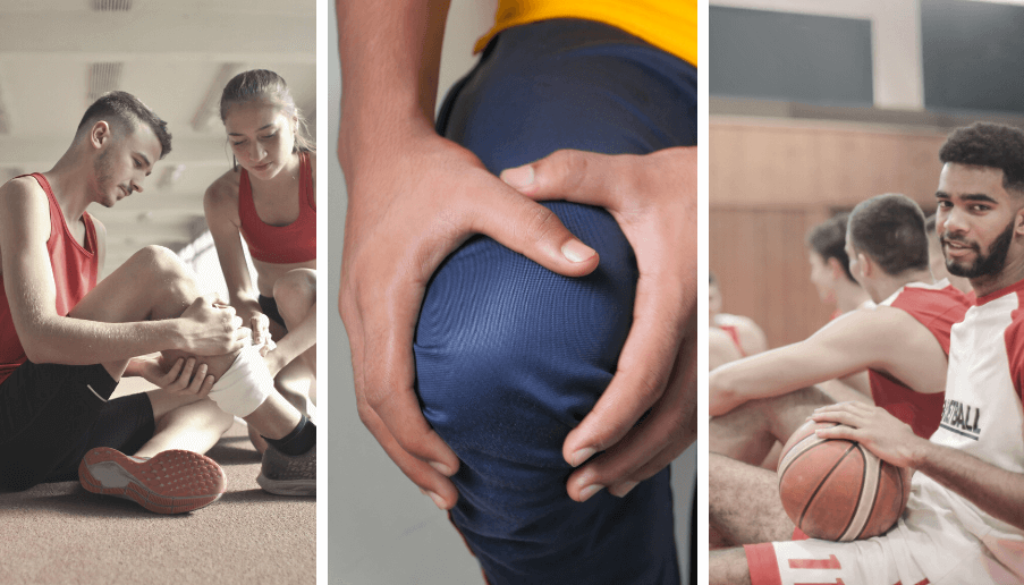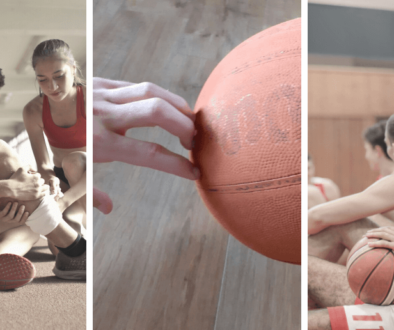Patellofemoral Pain: A Basketballers Guide
It has been a while since I did a post about common basketball injuries and thought it was about time I got back on track with the ‘basketballers guide’ series. Last time out, I looked at the third most common injury type being knee pain/injuries. In the last blog though, I focussed purely on patellar tendinopathy. However, there are plenty more types of knee pain to get through so I thought I would start back up with patellofemoral pain.
Patellofemoral pain is something that I have been speaking to a lot more people about recently and thought that it would be a great place to get the series going again. Why have I been seeing it more just lately? Well, at the moment, I think the answer is that ballers are starting to ramp up their training now we can return again. Another factor could be playing more outside on harder concrete surface as indoor courts have been closed. However, there are many other reasons and I will get to these in a bit further into the ballers guide.
What is Patellofemoral Pain?
Patellofemoral pain is pain at the front of your knee, around your kneecap (patella). If you are unsure why the femoral part is in the name…that’s because the patella moves in the femoral groove (the end of the thigh bone). It is the area that is most commonly attributed to the pain.
You may also hear people refer to patellofemoral pain as “runner’s knee” too, the terms are interchangeable. Patellofemoral pain is usually more common in people who participate in sports that involve running and jumping. I think we can all agree that basketball involves plenty of running and jumping and therefore, why it can be a common source of pain. Despite it being common, it is generally easy to remedy if you take the right steps. Some may need more rehab than others though.
Symptoms
Patellofemoral pain is usually reported as a dull, aching pain in the front of the knee, usually around the kneecap. Often, the pain increases when you:
- Run
- Walk up or down the stairs
- After sitting for a period of time
- Squat/lunge
- Jump
Generally, there are no other symptoms other than pain. If there are other symptoms such as swelling, clicking or clunking noises, locking (knee getting stuck in a bent position) or giving way, it may be a different diagnosis. If this is the case for you, then it may be worth having a chat with a therapist or doctor.
I just want to add that…isolated clicking, clunking and popping symptoms (without pain) are usually nothing to worry about.

Causes of Patellofemoral Pain
The causes for patellofemoral pain are not that definitive and as with other conditions, frequently debated by healthcare professions. This can make it confusing for some individuals, as you may be told different things by different professions. Commonly though, it is associated with:
- A sudden increase in activity – especially running and jumping
- Reduced flexibility of quadriceps and poor mobility of the knee
- Poor conditioning of quadriceps and hip muscles
- Injury or direct trauma to the kneecap
- Following a surgery
Risk factors for Patellofemoral Pain
There can be a number of risk factors for patellofemoral pain and it is not always a simple case of too much exercise:
- Age – it is more common in adolescents and young adults
- Sex – women are twice as likely to develop this type of pain compared to men. This may be because of women having wider pelvis’ and this increases the angle of the thigh bone.
- Basketball – unfortunately running and jumping is the main risk factor. However, that does not mean you have to stop playing. Although, it does mean that S&C and recovery strategies are vitally important.
- Weight – although not typically seen in risk factors for patellofemoral pain, excess weight could load the knees more.
- Stress/Anxiety/Depression – as with all pain issues, you may be at more risk at a time your mental health is being impacted by something.
- Poor recovery strategies.
Minimising risk for Patellofemoral Pain
A sudden increase in activity is often the main cause, so taking your time to grade up activity is best. If you are thinking of building up weight training (strength & conditioning) to compliment your game and minimise risk, start steady and gradually build. Get support with building a routine or plan.
Disturbed sleep, anxiety and depression can all be associated with increases in pain. Making sure you improve sleep and manage your mental health can minimise the risk of pain and flare-ups. Nutrition can also have a part to play in recovery from training, games and injury.
Remember, good recovery strategies are just as important as your training.
The following tips can help you minimise the risk of patellofemoral pain or recurring problems:
Sometimes knee pain just happens and there are no underlying causes, however, following these steps may help to prevent pain:
- Conditioning the quads and hip abductors (muscles that move the leg away from the bodies midline) so the knee can tolerate running, jumping and landing.
- Technique – work on jumping, running and pivoting techniques. The better your landing mechanics, the less load goes through the knee
- Practice stability training, including balance exercises.
- Maintain a good weight and fuel your body right for training and recovery.
- Warm-up properly – not just a 5-minute half-hearted stretch and then straight into layup lines. Take your body through a good 10-20 minute warm-up before training and games.
- Increase the intensity of training gradually.
- Appropriate footwear – make sure your boots fit well.
Supports and taping can be utilised, but should not be a replacement of the above.
Treatment for Patellofemoral Pain
As always, the first thing I recommend doing when it comes to managing any pain problem is addressing any current risk factors. What is currently going on life that will be a barrier to recovery? Without addressing activity cycles, stressors and lifestyle factors, you may just keep banging your head against a wall when it comes to treatment and rehab.
Modify not Rest
Patellofemoral pain may improve with complete rest. This may be a bit of a false economy though, as rest may help symptoms settle but many get frustrated that symptoms increase again when returning to activity. Rest generally doesn’t help because it doesn’t increase the tolerance of the tissues to the loading demands required. Initially, modifying activity is best and being wary of activity cycles you have fallen into.
Exercise is one of the most evidence-based treatments there is for patellofemoral pain. Progressive loading of the muscles that support your knee (quadriceps, hamstrings and hip abductors) is required for improvement. Gradually building up the load can help develop tolerance to the required loads for both daily and sporting activity. Exercise often needs to be individualised (strengthening different muscle groups to those mentioned may be needed for some), so speak to your therapist about this or drop us a message.
If you do need to take complete rest from basketball, I would recommend that you keep training the rest of your body. Don’t forget, ball handling and shooting practice can still be done; even if it has to be done from a chair! You may also find that swimming, cycling or aqua jogging can help keep your fitness up whilst off-loading the knee. Other cross-training ideas:
- Pilates
- Yoga
- Circuits
- Weight-training
- Rowing
- Cross-trainer (other gym equipment)

Should I use Ice?
The research for ice is poor. However, if you find it useful, generally there is no harm in using it during acute stages. If you are going to use ice, please take care and do not apply directly to the skin or for too long. Ice burns can be caused so regularly check your skin when using. Do not use an ice pack where you have numbness, decreased sensation or poor circulation.
Should I use Anti-inflammatories?
Inflammation might not be a big factor with many people experiencing patellofemoral pain. Therefore, anti-inflammatories are not helpful for many. They may be helpful in the early acute stage but might not be best to take in the longer term. It is also important to remember, that if there is any inflammation happening in the first 48-72 hours, our body needs this to recover, don’t be too quick in grabbing anti-inflammatories.
If you are struggling with pain levels, it is always best to speak to a pharmacist or doctor to see what pain relief medication may be best for your situation.
Is a Scan required for Patellofemoral Pain?
Changes on MRI scan do not equal the amount of pain or pain someone experiences. Some people can have severe pain and no changes in their imaging whilst others may have a lot of changes and no pain. In addition, the severity of the changes seen on a scan does not mean you can’t get better or have a poorer outcome.
Even if your pain and symptoms are persisting, MRI scan and other diagnostic tests may not be helpful. Even when someone improves their symptoms and function, the changes on a scan can remain. Therefore it is best to target treatment towards improving pain and building function.
Injections, massage, ultrasound and passive treatments?
These treatments are often adjuncts to load management and exercise and evidence is limited to them speeding up recovery.
For some individuals, these passive treatments do help to calm down symptoms but do not be disheartened if they don’t. If they do, remember they are there to help you calm it down so you can gradually build load. Try not to fall into the trap that if the pain is better you can rush back to exercise/load.
Rehab, rehab, rehab for Patellofemoral Pain!!
If it was not already clear, rehab is the way to go for most and should consist of a series of exercises to restore your thigh’s range of motion, strength, flexibility and stability. Exercises will need to be progressed to ensure you continue to improve. The level of exercises is usually based on pain tolerance levels; this can vary from person to person.
Proprioception, balance and agility training are important and often missed steps in rehab. This allows the muscles that support the knee to get used to the demands of basketball again. Grading this up is again essential to prevent you from going backwards in rehab. These exercises may involve various degrees of balance challenges, such as standing on one leg and dribbling a basketball or change of direction drills.
Return to Ball
If you had to stop basketball, it is important to build up basketball-specific drills as part of rehab. By this I mean, layups, jump stops, pivoting, rebounding and cutting. You can turn these activities into sport-specific rehab drills. Building this up gradually is crucial, those that return too soon or try rushing rehab often go backwards and recovery takes longer.
If you are struggling to get the right balance of activity, seeing a performance coach, rehabilitator or therapist may be required. They can help with training loads and put a suitable plan together to reduce the risk of reoccurrence.
A gradual return to training and games is also recommended.
Final Notes
That’s the basketballers guide to patellofemoral pain. You may also find the soft tissue injury guide is also helpful and can be downloaded for free here.
Remember, these resources should not replace diagnosis and management from a medical professional. Always check before you follow the guidance. If you have any questions…feel free to leave a comment or drop us an email.




